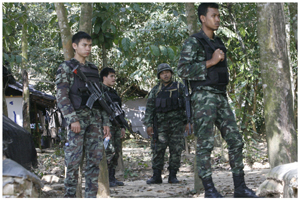Similarities of the two daring attacks by southern insurgents
 There were several similarities between the January 19 attack on the 15121st infantry company’s outpost in Ra-ngae district, Narathiwat and the January 4 assault by Islamic insurgents on the Peeleng camp of the 4th development battalion in Cho-airong district, also in Narathwiat, seven years ago.
There were several similarities between the January 19 attack on the 15121st infantry company’s outpost in Ra-ngae district, Narathiwat and the January 4 assault by Islamic insurgents on the Peeleng camp of the 4th development battalion in Cho-airong district, also in Narathwiat, seven years ago.
Lt-Gen Nanthadej Meksawat, former chief of the Southern Special Operations Centre, said this data in an opinion piece, titled “The insurgents’ declaration of power over the state”, he recently contributed to an online newspaper.
The insurgents stole more than 400 pieces of firearms, including many M16 assault rifles, on the January 4, 2004, attack. In the latest attack, the insurgents made off with more than 20 war weapons, according to an army spokesman.
- The location of the two camps. Lt-Gen Nanthadej pointed out that both camps which are 30 kilometres apart are surrounded by Budo, Tawae and Nai mountains. The three mountains have long been used as hideouts of the insurgents.
- The timing of the attacks. In both incidents, the insurgents timed their attack when the troops stationed in both camps were relaxing after having finished with their dinner and hence, they were not on full alert.
- The means of attacks. The insurgents split into two groups with the first launching a frontal attack as a diversion ploy to lure troops to the front. The main raiding force attacked from the rear which, in both cases, is covered with rubber trees.
- Retreating tactic. In both incidents, sympathizers of the insurgents were deployed to scatter spikes, burn used tyres and and cut down trees to block access to the camps and to slow down reinforcements.
- There might be spies in the two camps.
Lt-Gen Nanthadej said that the similarities of the two events prompted some critics to question whether the army have ever learned a lesson from the January 4, 2004 incident. Although there were several similarities, he said there are also some differences between the two events.
- The 15121st outpost is located in a Red Zone whereas the Beeleng camp is not. Local people in Tambon Maruebodok, Ra-nage district, requested that the troops set up the outpost in the locality for their own protection and that of other officials. The army had no other choices but to meet the local people’s request.
- The outpost is a temporary camp with knock-down lodgings and without any fence.Because the camp was built on people-friendly concept without any barricade, it was seen as a psychological strength but, in military concept, it was a great weak point. The army chose the friendly approach and had to take the risk for making the camp vulnerable.
- The insurgents employed more deadly weapons in the latest attack. These included M79 grenade launchers and hand grenades.
- Most of the insurgents involved in the latest attack are ruthless and have extensive experiences in killing their opponents.
To better cope with the insurgents, the former intelligence officer suggested that the army must employ more technological equipments such as more surveillance cameras to be installed in public places.
The retired general noted that it was imperative that the state must take full control of all the main routes in the three southernmost provinces otherwise no villagers would dare to come forward to the authorities to volunteer information or to support the government.
He warned that one day the insurgents might be strong enough to close down a town to rob a commercial bank as is the case in Iraq.
Meanwhile, Lt-Gen Udomchai Thammasarorach, commander of the Fourth Army Region, played down the suspcision that there might be some spies in the camp in Ra-nage district.
In a press conference held on Sunday January 22, Lt-Gen Udomchai said the suspicion was spread out by some ill-intent elements to foster division between Buddshist officials and Muslim officials. He noted that similar suspicion was raised in the aftermath of the attack eight years ago.
The general also dismissed as untrue the belief that the insurgents had grown stronger in strength and were able to mount large-scale attack against security forces. They simply took advantage of the situation when our troops were not on guard, he said.
